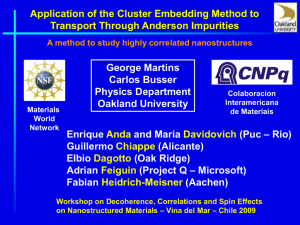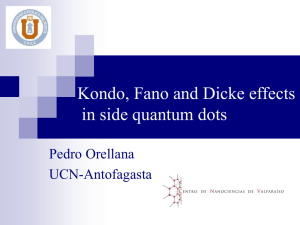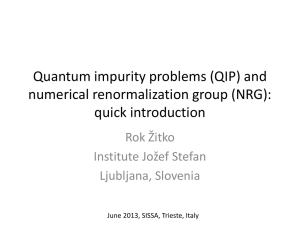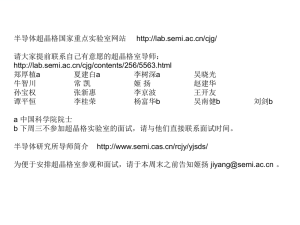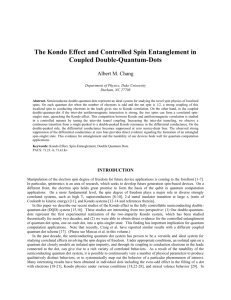Supplementary Discussion - Word file (42 KB )
advertisement
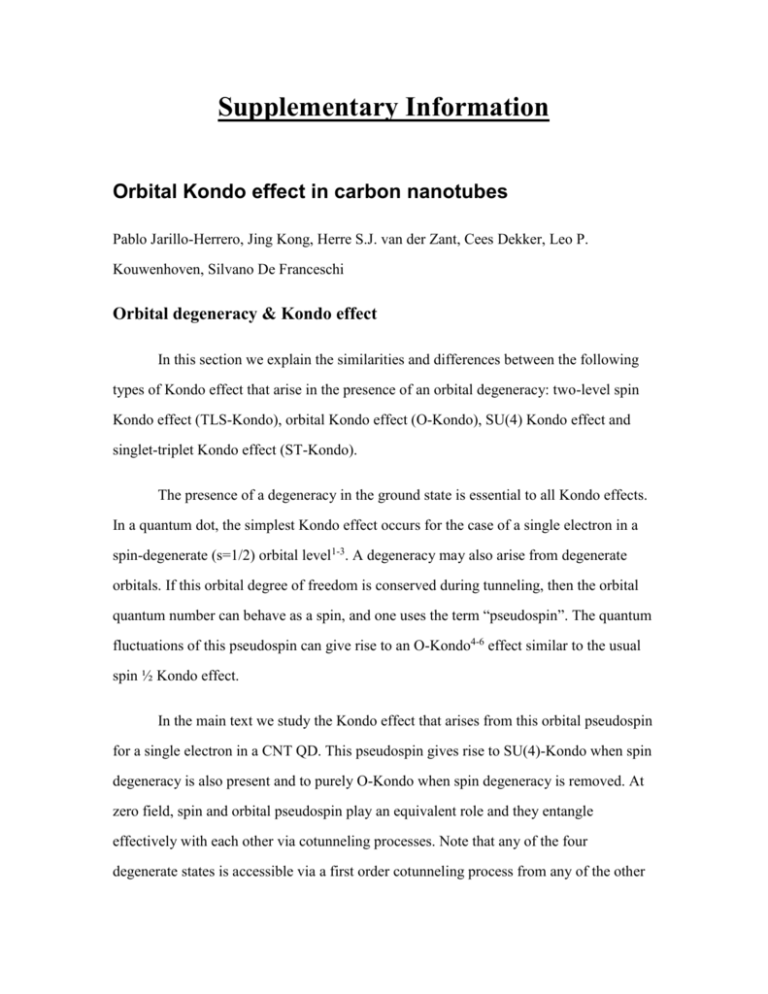
Supplementary Information Orbital Kondo effect in carbon nanotubes Pablo Jarillo-Herrero, Jing Kong, Herre S.J. van der Zant, Cees Dekker, Leo P. Kouwenhoven, Silvano De Franceschi Orbital degeneracy & Kondo effect In this section we explain the similarities and differences between the following types of Kondo effect that arise in the presence of an orbital degeneracy: two-level spin Kondo effect (TLS-Kondo), orbital Kondo effect (O-Kondo), SU(4) Kondo effect and singlet-triplet Kondo effect (ST-Kondo). The presence of a degeneracy in the ground state is essential to all Kondo effects. In a quantum dot, the simplest Kondo effect occurs for the case of a single electron in a spin-degenerate (s=1/2) orbital level1-3. A degeneracy may also arise from degenerate orbitals. If this orbital degree of freedom is conserved during tunneling, then the orbital quantum number can behave as a spin, and one uses the term “pseudospin”. The quantum fluctuations of this pseudospin can give rise to an O-Kondo4-6 effect similar to the usual spin ½ Kondo effect. In the main text we study the Kondo effect that arises from this orbital pseudospin for a single electron in a CNT QD. This pseudospin gives rise to SU(4)-Kondo when spin degeneracy is also present and to purely O-Kondo when spin degeneracy is removed. At zero field, spin and orbital pseudospin play an equivalent role and they entangle effectively with each other via cotunneling processes. Note that any of the four degenerate states is accessible via a first order cotunneling process from any of the other states (see Fig. 1c, main text). As a result of this strong entanglement the state of the dot can be mapped onto a four-component “hyper-spin” space where the Hamiltonian takes a highly symmetric form that transforms according to the SU(4) group7-9. We therefore denote the present effect as SU(4)-Kondo. The corresponding phase shift associated with the transmission of electrons across the dot is /4. This sets an upper limit to the conductance of G = 2e2/h [sin2 (1/2*/2) + sin2 (1/2*/2)] = 2e2/h. It is worth noting that the same value for the maximum conductance is also obtained for the ordinary spin-½ and O-Kondo effects, but this time due to a /2 phase shift and the corresponding symmetry is SU(2) (G = 2e2/h [sin2 (1*/2)] = 2e2/h)7-12. The four-fold degeneracy in the SU(4)-Kondo effect leads to a Kondo temperature much higher than in the ordinary spin = 1/2 case7-12. A similar enhancement of TK occurs for the TLS-Kondo and ST-Kondo effects, where the degeneracy is also four-fold. In these cases, however, the physics is fundamentally different. Basically none of these Kondo effects would exist for spinless electrons, while the SU(4)-Kondo would be reduced to an SU(2) orbital Kondo effect in the absence of spin. The ST-Kondo effect occurs for two electrons in the dot, due to the degeneracy between two-particle singlet and triplet states. It was discovered in semiconductor quantum dots13,14 giving rise to extensive theoretical work 15-21. In the ST-Kondo effect the orbital degree of freedom does not act as a pseudospin. Instead, it simply provides the extra orbital necessary to form the two-particle triplet state. In contrast to the SU(4)Kondo effect, here the 4 states for ST-Kondo are not all mutually connected via a firstorder cotunneling process. For example, the Sz = +1 triplet state, |,, cannot go to the triplet Sz = 1, |,, via a first order cotunneling process, since for this process |Sz| = 2. The symmetry of the ST-Kondo effect is not SU(4) as it can be deduced from the analysis of the corresponding phase shifts22,23. It is worth noting that we also observe the ST-Kondo effect in our devices in the case when 2 electrons occupy a shell (this occurs at finite field, B~0.35 T, for region II (not shown), and at zero field for the shell on the left side of Fig. SI2). In our nanotube devices, as well as in semiconductor vertical quantum dots13, the upper limit to the conductance is G = 4e2/h18,20. Consistent with this expectation we observe a Kondo-enhanced conductance larger than the one channel limit of 2e2/h (note the peak conductance of 3e2/h for the shell on the left in Fig. SI2). The TLS-Kondo and SU(4) Kondo effects are more difficult to distinguish experimentally at zero field. They occur both for a single electron in the dot. In both cases the upper limit to the conductance is 2e2/h and there is a similar enhancement of TK due to orbital degeneracy. Recent calculations24 show that the distinction is possible at finite B because the Kondo resonance splits in two for TLS-Kondo (TLS-Kondo gives rise to no orbital Kondo resonance) while it splits in 4 for SU(4) Kondo. These results are in agreement with our experiments. Besides this, the Kondo effect at large B, due to the recovery of degeneracy between orbital states with equal spin polarization, proves the presence of orbital Kondo correlations in CNTs at zero field. Even in the presence of a coupling, , between orbital states, since < kBTK (at B=0), the conditions for the observations of an SU(4) Kondo effect are fulfilled7. Single particle energy spectrum & G(VG, B) spectroscopy In this section we show how we identify the orbital Kondo effect shown in Fig. 2 with the degeneracy between the equally polarized orbital states |+, and |, (neglecting the orbital coupling). Figure SI1a shows the same single particle energy spectrum as in Fig. 1d, where we have added the labels A, B, C and D. is the energy spacing between consecutive shells. The diagrams in Fig. SI1b represents the orbital and spin configuration of the CNT QD with one electron in the highest energy shell (the lower energy shells are fully occupied) at (E,B) positions A to D. In Fig. SI1c, the correspondence between the single particle energy spectrum and a G(VG,B) diagram (representing the measurements shown in Fig. 2a) is shown. U is the charging energy. At zero field (A), the electron occupies a four-fold degenerate state, giving rise to an SU(4) Kondo effect. This shows up in Fig. SI1c as a conductance ridge inside the Coulomb blockade area. As the magnetic field is increased, the degeneracy is broken (B) and the electron occupies the lowest energy level, that is |,. At C, there is a level crossing between states |, and |+,. Due to the exchange interaction, the kink in the B-evolution of the corresponding Coulomb peak appears at a lower value of the magnetic field (C’ in Fig. SI1b,c), when the single particle states have not crossed yet. This kink denotes a singlet to triplet transition in the region where the QD is occupied by four electrons (full shell). The singlet-triplet transition for a full shell occurs because one of the two electrons in energy level |+ (specifically |+,) promotes to energy level |, (from the next unoccupied shell) as soon as their energy difference is less than the exchange interaction. An enhanced conductance ridge is observed correspondingly (see also Fig. 2a). From C’ on, the last added electron to the QD occupies the state |+,, until a new level crossing occurs at D, between |+, and |,. Here the single electron can occupy any of the two orbital states, but in both cases with spin down. A purely orbital Kondo effect can then take place and a conductance ridge is seen (see Fig. SI1c and Fig. 2a). A similar Kondo effect can take place in region III. In this case, however, Kondo effect takes place between states |+, and |,. In a clean CNT, without disorder, this Kondo effect should take place at the same magnetic field value. Therefore a gate controlled bipolar low-impedance spin filter can, in principle, be realized7. By changing the gate voltage (from region I to III), we can change the filter polarity while the enhanced conductance due to Kondo effect ensures the low impedance. Temperature dependence Here we show the T-dependence of the linear conductance data shown in Fig. 3a at B=0 (Fig. SI2). Starting from T =8 K (thick red trace), G increases by lowering T in the regions corresponding to partially filled shells and decreases for full shells. In the centre of valleys I and III, G exhibits a characteristic logarithmic T-dependence with a saturation around 2e2/h at low T, indicating a fully-developed Kondo effect (see Fig SI2, top inset, second from left). Similar T-dependences, although with different values of G0 and TK, are observed for the neighbouring shells. The coupling to the leads increases as VG decreases (the measurements are taken on the “valence band” of the small band gap)25. From fits to the formula G=G0/(1+(21/s-1)(T/TK)2)s (ref. 26), with s=0.21, taken at the VG values indicated by arrows in Fig. SI2, we find TK = 6.5, 7.7, and 16 K, respectively. These Kondo temperatures are an order of magnitude higher than those previously reported for nanotube QDs27,28 and comparable to those reported for single-molecule devices29,30. Such high TK values, and the fact that G exceeds 2e2/h (the one-channel conductance limit) for two particles, are signatures of non-conventional Kondo effects (see Orbital degeneracy & Kondo effect above). The bottom inset in Fig. SI2 shows the normalized conductance, G/G0, versus normalized temperature, T/TK, for different shells and for both one and two electrons in the shell. The observed scaling reflects the universal character of the Kondo effect. The low-temperature behaviour is fully determined by a single energy scale, TK, independent of the spin and orbital configuration responsible for the Kondo effect. Fabrication and measurement setup Here we include a more detailed description about the sample fabrication procedure and measuring setup. The nanotubes were grown by chemical vapor deposition (CVD)31 on degenerately p-doped silicon wafers (heavy p-type, or n-type, doping is necessary to make the substrate conductive at low temperature so that it acts as a backgate) with 250nm thermally grown oxide. For the catalyst, 40mg of Fe(NO3)3·9H2O, 2mg of MoO2(acac)2 (SigmaAldrich), and 30mg of Alumina nanoparticles (Degussa Aluminum Oxide C) were mixed in 30ml of methanol and sonicated for ~1hr. The resulting liquid catalyst is deposited onto the substrate with 0.5m2 openings in the PMMA resist and blown dry. After lift-off in acetone, the substrate with patterned catalyst is placed in a 1inch quartz tube furnace and the CVD is carried out at 900C with 700sccm H2, 520sccm CH4 for 10 min. Argon is flown during heating up and cooling down. The methane and hydrogen flows have been optimised to obtain long and clean nanotubes (~10m) without amorphous carbon deposition. The nanotubes are located with atomic force microscope (AFM) inspection and e-beam lithography is then carried out to pattern electrodes over the nanotubes. Our electrodes are customized for each device, and we typically choose straight and uniform sections of nanotubes in areas free of residues. The metal electrodes are deposited via e-beam evaporation and a typical thickness of 20nm Ti and 40nm Au is used. Normally a thin Ti layer (~5nm) is used as a sticking layer, but we have noticed that thicker Ti layers (~20nm) give, on average, lower contact resistance. Nevertheless, there is always a wide distribution in the conductance of the nanotube devices, even if grown on the same substrate, probably due to the different diameters and chiralities present. We used two setups to measure the NT-devices: - Dilution refrigerator (Leiden Cryogenics, MK126 700) with a base temperature of 25mK (data in Fig. 2). The measurement wires have room temperature -filters as well as low-temperature copper-powder filters. From inelastic cotunneling measurements32,33 performed in our nanotube devices, we estimate an upper limit to the effective electron temperature of 100mK. The actual value is most likely lower, since effective electron temperatures below 50mK have been routinely observed in the same setup. - 3 He-system (Heliox, Oxford instruments), equipped with room temperature - filters. Here the effective electron temperature was measured to be 340mK from fits to the width of thermally broadened Coulomb peaks in similar nanotube devices. The data in Fig. 3 and SI2 were taken in this setup. For both setups, the differential conductance is measured with a lock-in amplifier (5V rms excitation voltage at 17.7Hz) as a function of source-drain bias voltage and/or gate voltage. In the T-dependence measurements, the conductance traces are taken after the temperature has reached the desired value and stabilised for a long time (~30 min), in order to ensure proper thermalization of the sample. All temperatures quoted are cryostat temperatures. References: 1. Goldhaber-Gordon, D. et al., Nature 391, 156 (1998). 2. Cronenwett, S.M., Oosterkamp, T.H. & Kouwenhoven, L.P. Science 281, 540 (1998). 3. Schmid, J., Weis, J., Eberl, K. & Klitzing, K.v. Physica B 256-258, 182 (1998). 4. Cox, D.L. & Zawadowski, A. Adv. Phys. 47, 599-942 (1998). 5. Kolesnychenko, O.Yu., de Kort, R., Katsnelson, M.I., Lichtenstein, A.I. & van Kempen, H. Nature 415, 507 (2002). 6. A zero bias anomaly in the context of an orbital degeneracy has been discussed by Wilhelm, U., Schmid, J., Weis, J. & Klitzing, K.v. in Physica (Amsterdam) 14E, 385 (2002). No temperature or magnetic field dependence data were reported, precluding a direct comparison with predictions for Kondo effect. 7. Borda, L., Zaránd, G., Hofstetter, W., Halperin, B.I. & von Delft, J. Phys. Rev. Lett. 90, 026602 (2003). 8. Zaránd, G., Brataas, A. & Goldhaber-Gordon, D. Solid State Comm. 126, 463 (2003). 9. López, R. et al., e-Print available at http://xxx.lanl.gov/abs/cond-mat/0402361. 10. Inoshita, T., Shimizu, A., Kuramoto, Y. & Sakaki, H. Phys. Rev. B 48, 14725 (1993). 11. Sasaki, S., Amaha, S., Asakawa, N., Eto, M. & Tarucha, S. Phys. Rev. Lett. 93, 017205 (2004). 12. Eto, M. e-Print available at http://xxx.lanl.gov/abs/cond-mat/0408159. 13. Sasaki, S. et al., Nature 405, 764 (2000). 14. van der Wiel, W.G. et al. Phys. Rev. Lett. 88, 126803 (2002). 15. Pustilnik, M., Avishai, Y. & Glazman, L.I. Phys. Rev. Lett. 84, 1756 (2000). 16. Giuliano, D. & Tagliacozzo, A. Phys. Rev. Lett. 84, 4677 (2000). 17. Eto, M. & Nazarov, Yu.V. Phys. Rev. Lett. 85, 1306 (2000). 18. Pustilnik, M. & Glazman, L.I. Phys. Rev. Lett. 85, 2993 (2000). 19. Pustilnik, M. & Glazman, L.I. Phys. Rev. Lett. 87, 216601 (2001). 20. Izumida, W., Sakai, O. & Tarucha, S. Phys. Rev. Lett. 87, 216803 (2001). 21. Hofstetter, W. & Schoeller, H. Phys. Rev. Lett. 88, 16803 (2001). 22. Pustilnik, M., Glazman, L.I. & Hofstetter, W. Phys. Rev. B 68, 161303(R) (2003). 23. Hofstetter, W. & Zaránd, G. Phys. Rev. B 69, 235301 (2004). 24. Choi, M., López, R. & Aguado, R. Submitted to Phys. Rev. Lett. (2004). 25. Jarillo-Herrero, P. et al., e-Print available at http://xxx.lanl.gov/cond-mat/0411440. 26. Golhaber-Gordon, D. et al., Phys. Rev. Lett. 81, 5225 (1998). 27. Nygård, J., Cobden, D.H., & Lindelof, P.E. Nature 408, 342-346 (2000). 28. Buitelaar, M.R., Bachtold, A., Nussbaumer, T., Iqbal, M. & Schönenberger, C. Phys. Rev. Lett. 88, 156801 (2002). 29. Park, J. et al. Nature 417, 722-725 (2002). 30. Liang, W., Shores, M.P., Bockrath, M., Long, J. R. & Park, H. Nature 417, 725-729 (2002). 31. Kong, J., Soh, H.T., Cassell, A.M., Quate, C.F., Dai, H. Nature, 395, 878-881 (1998). 32. De Franceschi, S. et al. Phys. Rev. Lett. 86, 878-881 (2001). 33. Kogan, A. et al. Phys. Rev. Lett. 93, 166602 (2004).
